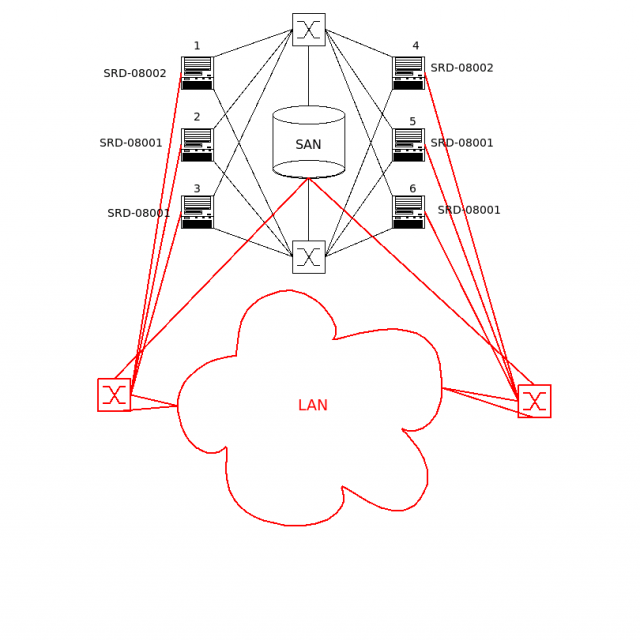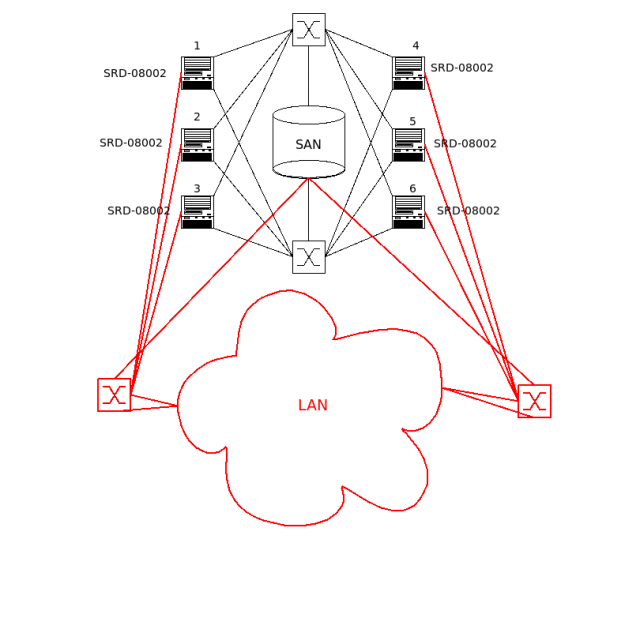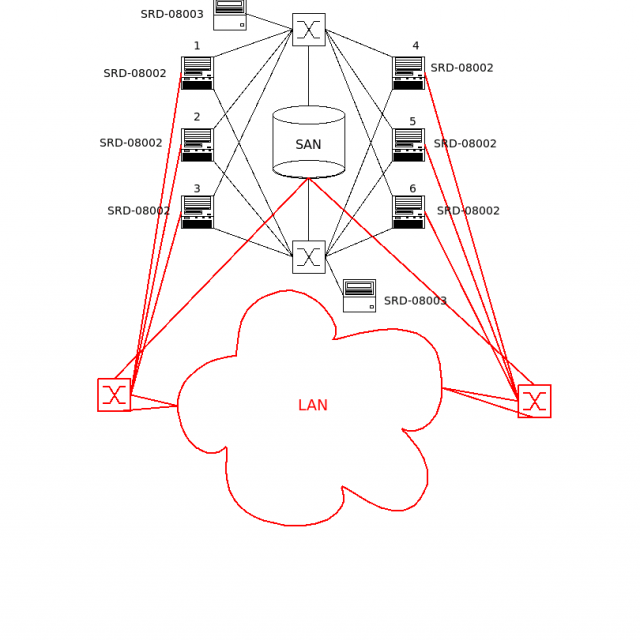SAN
Explanation of SEP sesam licensing for Explanation of SEP sesam licensing for SAN environments
I. Included: SEP sesam Server If data is written from the SEP sesam Master Server directly to the SAN (locally or directly connected) no license is required.
II. Low Cost: SEP sesam SAN Remote Device Client  If data is written to a SAN from SAN connected server and controlled by the SEP sesam Server a license is required. When data is written from a remote device or client server to another server on the SAN using SEP sesam client software a SEP-SRD-08001 license is required. In this example the SEP San Server license SRD-08002 is running on Servers 1. The SEP SAN server controls the other SAN Client servers 2 through 6. Servers 2 thru 6 are each running SRD-08001 (SAN Client License). Data from the clients is written to the SAN and Meta Data regarding the backups is stored on the SEP sesam SAN Server. This operation is sequential and not dynamic, i.e. Server 2 starts to write to the SAN, when it is finished the Server 3 writes to the SAN.
If data is written to a SAN from SAN connected server and controlled by the SEP sesam Server a license is required. When data is written from a remote device or client server to another server on the SAN using SEP sesam client software a SEP-SRD-08001 license is required. In this example the SEP San Server license SRD-08002 is running on Servers 1. The SEP SAN server controls the other SAN Client servers 2 through 6. Servers 2 thru 6 are each running SRD-08001 (SAN Client License). Data from the clients is written to the SAN and Meta Data regarding the backups is stored on the SEP sesam SAN Server. This operation is sequential and not dynamic, i.e. Server 2 starts to write to the SAN, when it is finished the Server 3 writes to the SAN.
III. High Performance: SEP sesam SAN Remote Device Server  If data is written from a SAN Remote Device Server to the SAN using SEP sesam the SEP sesam license SEP-SRD08002 is required for the server (node) writing to the SAN. In this example, the SEP sesam SAN server requires an SRD08002 license and and the other Servers or SAN Clients require an SRD08001 SAN client license and each write to the SAN (black lines). During the backup operation Server 1 will start writing data to the SAN, when it finishes Server 2 writes to the SAN, then Server three and so on until all backup jobs are complete. In other words, this is a sequential backup of SAN attached servers. This is an obvious improvement of speed while performing backups because all data transacts via the SAN and away from the LAN.
If data is written from a SAN Remote Device Server to the SAN using SEP sesam the SEP sesam license SEP-SRD08002 is required for the server (node) writing to the SAN. In this example, the SEP sesam SAN server requires an SRD08002 license and and the other Servers or SAN Clients require an SRD08001 SAN client license and each write to the SAN (black lines). During the backup operation Server 1 will start writing data to the SAN, when it finishes Server 2 writes to the SAN, then Server three and so on until all backup jobs are complete. In other words, this is a sequential backup of SAN attached servers. This is an obvious improvement of speed while performing backups because all data transacts via the SAN and away from the LAN.
IV. Highest Performance: SEP sesam Dynamic Drive Sharing with sesam Remote Device Server 
SEP sesam Dynamic Drive sharing is a methodology that allows multiple backup jobs to exist within a queue and allows them to be performed simultaneously, improving performance and fully utilizing the speed of the SAN. If a server writes data directly to the SAN (LAN free backup) a SEP SAN client licenseSRD08001 is required for each SAN attached Server (Node). In the example provided all servers are connected (hence licensed) to and write data directly to the SAN, via the SAN switch pictured. By installing the SAN Dynamic Drive Sharing license (SEP-SRD08003) on each available SAN attached Disk or Tape all nodes can write to the SAN at the same time substantially increasing performance and decreasing the amount of time required for performing backup tasks.
- In the previous example, when a node is writing to the SAN tape drive (or disk drive) SEP sesam holds the 2nd backup job (or multiple jobs from same Node) in reserve. In this case backups to the SAN are performed sequentially, i.e. Server 1 starts and finishes its transfer of data to the SAN, then Server 2 starts and finishes, and so on until all six servers have transferred their backup data to the SAN.
- With Dynamic Drive Sharing all servers write to the available SAN disk or tape simultaneously.
Request Call
Leave us your information and we will reach out to you shortly!
Media Library
Browse videos from SEP's YouTube channel.



